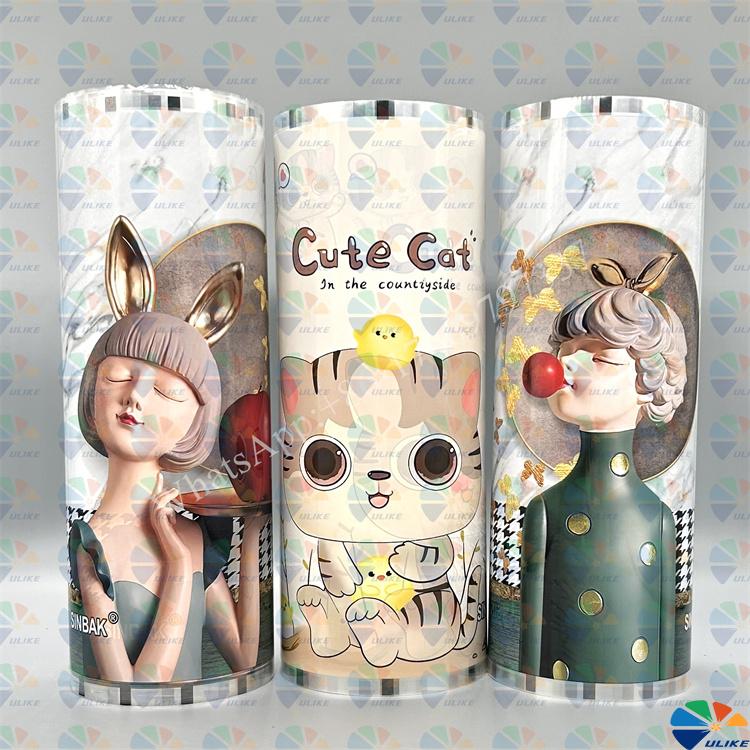Color thermal transfer
Color thermal transfer
1. Color thermal transfer
With the continuous improvement of people's living standards and aesthetic views, color printing has long replaced monotonous black and white printing.
Color thermal transfer printing, which has been popular for less than 20 years, is deeply loved by manufacturers for its many excellent characteristics such as realistic patterns, rich layers, bright colors, accurate color registration, small color difference, high gloss, and good reproducibility.
2.
Color thermal transfer film printing
Color thermal transfer film picture
So, how does color thermal transfer achieve gorgeous and complex color thermal transfer film printing?
1. Color thermal transfer plate making
The needs of modern design are diverse and varied. Only restoring the colors of some image originals cannot meet the required requirements. Therefore, color printing uses color plate technology to change or convert the order and quantity of color plates to achieve special color design requirements.
Color thermal transfer uses the production of thermal transfer electric engraving plates to achieve the special effects of color thermal transfer film printing with realistic patterns and rich colors.
Color thermal transfer plate making, typesetting technicians determine how many electric engraving plates are needed for the color thermal transfer film pattern based on the AI, CDR, and PS layered artwork provided by the customer, and how many electric engraving plates can fully reproduce the established pattern effect.
2. Four-color marking of color thermal transfer
The printing of color thermal transfer film uses red, yellow, blue, and black to produce ever-changing colors. It can use color separation plate making to print various colors.
The color of the text or graphics desired in the color thermal transfer artwork design can be checked by the "PANTON" Pantone color card number to check the CMYK value of each color. However, some special colors such as gold, bank and fluorescent colors cannot be composed of four-color ink overprinting, and must be printed with spot color ink of the spot color plate.
When encountering spot color patterns such as corporate LOGO, gold printing, silver printing, or other special effects, spot color plate ink or special process is required to print them.

![af]() Afrikaans
Afrikaans![sq]() Albanian
Albanian![am]() Amharic
Amharic![ar]() Arabic
Arabic![fr]() French
French![es]() Spanish
Spanish![ru]() Russian
Russian![de]() German
German![hy]() Armenian
Armenian![it]() Italian
Italian![ja]() Japanese
Japanese![ko]() Korean
Korean![pt]() Portuguese
Portuguese![hi]() Hindi
Hindi![az]() Azerbaijani
Azerbaijani![ro]() Romanian
Romanian![pl]() Polish
Polish![th]() Thai
Thai![el]() Greek
Greek![eu]() Basque
Basque![en]() English
English![zh-CN]() Chinese (Simplified)
Chinese (Simplified)![zh-TW]() Chinese (Traditional)
Chinese (Traditional)![be]() Belarusian
Belarusian![bn]() Bengali
Bengali![bs]() Bosnian
Bosnian![bg]() Bulgarian
Bulgarian![ca]() Catalan
Catalan![ceb]() Cebuano
Cebuano![ny]() Chichewa
Chichewa![co]() Corsican
Corsican![hr]() Croatian
Croatian![cs]() Czech
Czech![da]() Danish
Danish![nl]() Dutch
Dutch![eo]() Esperanto
Esperanto![et]() Estonian
Estonian![tl]() Filipino
Filipino![fi]() Finnish
Finnish![fy]() Frisian
Frisian![gl]() Galician
Galician![ka]() Georgian
Georgian![gu]() Gujarati
Gujarati![ht]() Haitian Creole
Haitian Creole![ha]() Hausa
Hausa![haw]() Hawaiian
Hawaiian![iw]() Hebrew
Hebrew![hmn]() Hmong
Hmong![hu]() Hungarian
Hungarian![is]() Icelandic
Icelandic![ig]() Igbo
Igbo![id]() Indonesian
Indonesian![ga]() Irish
Irish![jw]() Javanese
Javanese![kn]() Kannada
Kannada![kk]() Kazakh
Kazakh![km]() Khmer
Khmer![ku]() Kurdish (Kurmanji)
Kurdish (Kurmanji)![ky]() Kyrgyz
Kyrgyz![lo]() Lao
Lao![la]() Latin
Latin![lv]() Latvian
Latvian![lt]() Lithuanian
Lithuanian![lb]() Luxembourgish
Luxembourgish![mk]() Macedonian
Macedonian![mg]() Malagasy
Malagasy![ms]() Malay
Malay![ml]() Malayalam
Malayalam![mt]() Maltese
Maltese![mi]() Maori
Maori![mr]() Marathi
Marathi![mn]() Mongolian
Mongolian![my]() Myanmar (Burmese)
Myanmar (Burmese)![ne]() Nepali
Nepali![no]() Norwegian
Norwegian![ps]() Pashto
Pashto![fa]() Persian
Persian![pa]() Punjabi
Punjabi![sm]() Samoan
Samoan![gd]() Scottish Gaelic
Scottish Gaelic![sr]() Serbian
Serbian![st]() Sesotho
Sesotho![sn]() Shona
Shona![sd]() Sindhi
Sindhi![si]() Sinhala
Sinhala![sk]() Slovak
Slovak![sl]() Slovenian
Slovenian![so]() Somali
Somali![su]() Sudanese
Sudanese![sw]() Swahili
Swahili![sv]() Swedish
Swedish![tg]() Tajik
Tajik![ta]() Tamil
Tamil![te]() Telugu
Telugu![tr]() Turkish
Turkish![uk]() Ukrainian
Ukrainian![ur]() Urdu
Urdu![uz]() Uzbek
Uzbek![vi]() Vietnamese
Vietnamese![cy]() Welsh
Welsh![xh]() Xhosa
Xhosa![yi]() Yiddish
Yiddish![yo]() Yoruba
Yoruba![zu]() Zulu
Zulu


